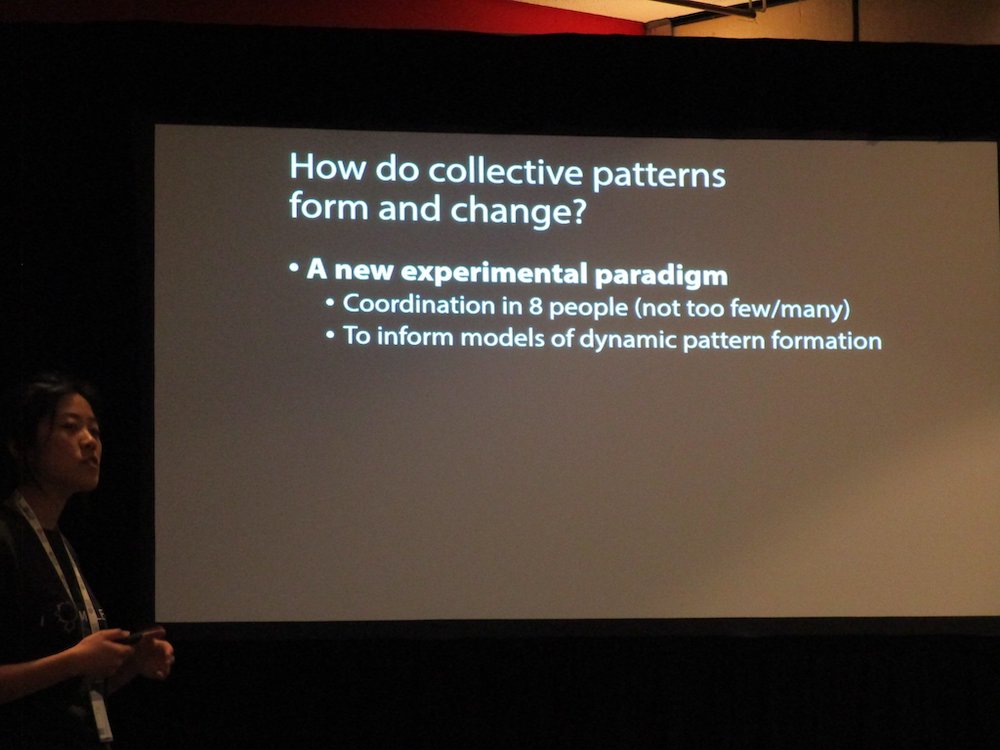Mengsen Zhang, current Ph.D. student of HBBL, presented her talk at Conference on Complex Systems 2017, in Cancun, Mexico, entitled “Multiagent Coordination Dynamics: The Human Firefly Experiment“.

Abstract: Living systems often contain oscillatory activities on multiple spatiotemporal scales. Studying the coordination among diverse oscillatory processes is essential for understanding the organization of complex structures and their behavior. Theoretical modeling has tended to focus on systems at either end of the spectrum: large-scale networks for their propensity to globally synchronize (with less attention given toward segregation into local structures) or systems with very few coupled oscillators (N≤3) that often exhibit a rich mix of integrative and segregative tendencies, but lack the necessary number of components to uncover organization at multiple spatiotemporal scales. In real-life human interactions, much happens in between. We have developed an experimental paradigm, dubbed the “human fireflies” to study the formation and evolution of coordinative structures in small groups (N=8 people). We aim to (1) examine the effect of symmetry breaking on collective dynamics; (2) characterize the forms of coordination that emerge at a micro level; and (3) provide benchmark experimental observations against which the relevance of theoretical models may be tested. Participants (8 people ×15 groups) were seated around an octagonal table and performed a rhythmic tapping task. Each participant was equipped with a touchpad that broadcast his/her tapping behavior to others, and an array of eight LEDs that displayed tapping behavior of self and others as brief flashes. Before each 50s period of interaction, participants were paced with a metronome (10s), and instructed to continue tapping at its frequency throughout the interaction while being attentive to others’ behavior. We manipulated the spatiotemporal symmetry of this eight-component system through metronome assignments, effectively splitting people into two groups of four such that frequencies were identical within groups, but different between groups. Symmetry breaking in the system was parametrically controlled by the frequency difference between the two groups (δf = 0, 0.3 or 0.6Hz). We examined under which conditions the groups remained segregated as two coordinative structures behaving at distinct frequencies, or integrated into a single superstructure in which the initial division into two groups was lost. Inferring from the relation between within- and between-group phase coordination, we identified the critical frequency difference that borders the régimes of integration and segregation. Close examination of the dynamics revealed that integration did not take the canonical form of stable phase relations (i.e. phase-locked synchronization). Rather a form of metastable relations emerged (i.e. recurrent dwells approaching stable phase relations, interleaved with escapes from said relations). In multiagent systems, such metastable coordination dynamics enables a component to switch between multiple coordinative structures in a recurrent fashion. Our results supply future theoretical studies of the dynamics of multiagent coordination with an empirical reference: plausible models ought to exhibit metastable coordination dynamics and contain a critical level of symmetry breaking that demarcates the boundary between segregation and integration. Such models will be useful to explore the consequences of different forms of coordination in terms of, inter alia, the complexity and stability of large-scale social networks, and more generally to aid discovery of laws of human behavior and their interaction.